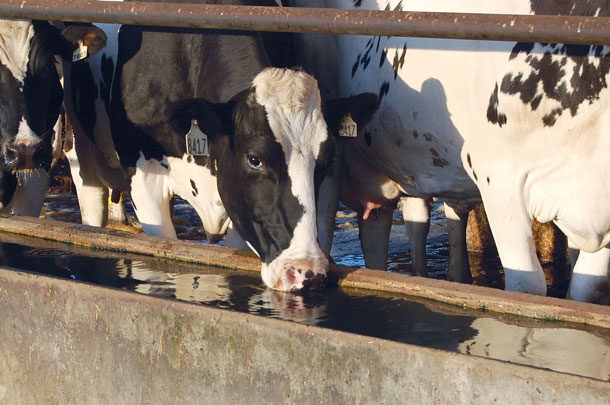Eighty-seven percent of a cow’s milk is water. So it is critical to recognize that providing clean, safe water is essential to maximizing herd performance and that not all water is acceptable for cows to drink.
What you can’t see or even taste may hurt a cow’s milk production, as well as her reproductive performance. For example, a readily available supply of high-quality water is necessary to help dairy cattle maintain blood volume, tissue function, rumen activity and proper feed flow through the digestive tract.
Common signs that poor water quality might be an issue on a dairy include:
- Cow health or performance problems
- Digestive upset or scours in replacement animals
- Deteriorating health in newly arrived heifers or dry cows
- Water has a off flavor, bad smell or odd color
- Digestive upset in humans drinking from the same water source
Adequate water consumption
Typically, each dairy cow consumes 30 to 50 gallons of water per day. Cows will spend four to five hours per day eating, but only 20 to 30 minutes per day drinking water. This makes easy access to water a critical factor in meeting their hydration needs. Drinking water provides dry and lactating cows 60 to 80 percent of their water needs, with feed providing most of the remainder. Water requirements vary with production levels and environmental temperature (see Figure 1).

The following management practices help optimize water consumption:
- Provide direct access to clean water as cows exit the milking parlor.
- Provide access to water within 50 feet of a feed bunk.
- Have at least two functioning waterers available per pen.
- Ensure adequate flow rate to maintain a minimum 3-inch water depth in the trough.
- Provide 3.5 linear inches of available trough space per cow.
- Monitor stray voltage in water troughs and the areas around them.
Water testing guidelines
To avoid poor water quality, water testing is recommended twice per year (late summer and late winter). Testing water quality requires an understanding of contaminants, including acceptable levels and their metabolic effects on dairy cows.
Typically, in dairy operations, it is recommended to test for the following:
- Total dissolved solids, pH and hardness
- Excess minerals or compounds (such as sulfate, chloride, iron, manganese and nitrates)
- Coliform and bacterial counts
- Toxic compounds (heavy metals, organophosphates, PCBs and hydrocarbons)
A water test is only as good as the sample and the laboratory testing it. Dairy producers should choose a reputable lab with experience testing water for livestock and dairy operations to ensure valid results. Also, it is critical to follow proper water sampling procedures to ensure an accurate water analysis. These include:
- Use sterile, plastic bottles supplied by the testing laboratory.
- Return water samples to the lab within 24 hours of collection.
- Sample the same water source as the animals drink.
- Collect samples from the stream running into the watering trough, not directly from the pool of water.
- Collect water samples from more than one pen, barn or water trough, in more than one location.
- Let the water run for several minutes before beginning to collect the sample.

Once the testing results are available from the lab, decisions can be made on how to address problems. Common water treatments include disinfection, water softening, iron filtration and reverse osmosis (see Figure 2). PD

Dana Tomlinson
Research Nutritionist
Zinpro Corporation
PHOTO: Photo provided by Zinpro Corporation.






